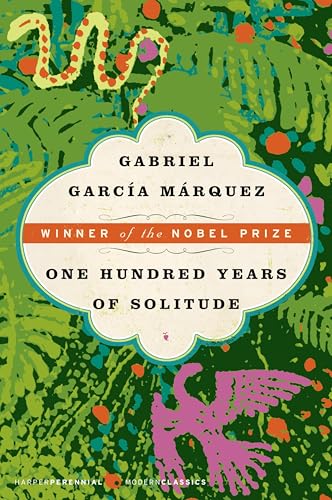Welcome, fellow book enthusiasts, to my humble review of One Hundred Years of Solitude. This book, penned by the legendary Gabriel García Márquez, sweeps you into the world of magical realism so vividly, you might just forget where you left your own reality. While the Buendía family’s antics kept me entertained, the historical backdrop added layers as thick as my grandma’s gravy. So, buckle up for a journey filled with both awe and, occasionally, a bemused scratch of the head. Is it worth the read? Grab a chair and let’s find out!
In a Nutshell
Oh boy, where do I begin with Gabriel García Márquez’s classic, One Hundred Years of Solitude? This novel belongs to the magical realism genre, where the extraordinary becomes ordinary, and vice versa. Márquez transports us to the fictional town of Macondo, where we trace the epic journey of the Buendía family across generations.
Márquez spins a tale that mixes love, war, fortune, and misfortune, all topped with a generous serving of the surreal. The themes of time, solitude, and fate are intricately woven into the story, leaving readers pondering life’s oddities. Through Márquez’s vivid storytelling, we experience how history repeats itself and reflects life’s cyclical nature. And yes, family drama takes center stage, adding even more spice to the narrative.
In true magical realism fashion, Márquez blurs the line between reality and fantasy, making this book a unique and unforgettable journey. I promise it’s a wild ride that will make you chuckle and ponder in equal measure!
Magical Realism: A Dance of the Extraordinary Within the Ordinary
Magical realism, my dear readers, is where the mundane goes to a jazz bar, gets a bit too tipsy, and then engages in a lively dance with the fantastical. In Gabriel García Márquez’s One Hundred Years of Solitude, this whimsical waltz takes center stage as the boundary between reality and fantasy wears thinner than cookie dough left in the sun. The book’s world, Macondo, isn’t just a backdrop but a living, breathing character where the impossible seems almost ordinary.
Take the fascinating weather reports, for example – four years, eleven months, and two days of rain! I once complained about three days of drizzle on my holiday to Brighton, but it was nothing compared to the drama Macondo faces. Or consider Remedios the Beauty, who ascends to heaven mid-laundry day. If only my socks could vanish so effortlessly!
In using magical realism, Márquez delivers not just a compelling story but also a powerful critique, subtly nudging readers to notice the absurdities that exist within our own reality. This genre blurs the lines, opening doors to a universe where the unthinkable becomes relatable, inviting us to dive deeper into its rich tapestry while pointing out the peculiarities we often overlook in our own lives.
Our next stop on this literary journey will take us through the tempestuous twists and turns of the Buendía family dynamics, where magic and reality further entwine in a captivating dance.
The Buendía Family: A Whirlwind of Chaos and Love
Oh, the Buendía family! If you think your family is chaotic, you clearly haven’t met these folks yet. In Gabriel García Márquez’s One Hundred Years of Solitude, the Buendías redefine the term ‘dysfunctional.’ It’s like watching a reality TV show, but with magical realism sprinkled throughout. Picture this: you’ve got a family tree that’s more tangled than my last attempt at Christmas lights. Honestly, keeping track of all the Aurelianos and José Arcadios gave me flashbacks to my high school algebra class, where I spent half the time wondering why the alphabet was suddenly full of numbers.
The dynamics within the Buendía family are a fascinating blend of love, fights, and that one uncle who probably forgot his kid’s name. The patriarch, José Arcadio Buendía, starts with big dreams of a utopian Macondo, but let’s be real – it ends up more like a two-day-old birthday cake in the rain, confusing and messy. The family members share a fate that seems eerily cyclical, which makes you wonder if they’re stuck in some cosmic spin cycle.
Despite the dysfunction, there’s a heartwarming core of love that keeps them together, even when they’re driving each other bonkers. It’s like watching a giant family reunion where everyone is yelling, but secretly, nobody would leave for the world. Márquez captures this chaos in a way that makes you look at your own family and think, ‘Hey, we’re not so bad after all.’
Stay tuned to uncover how history and politics wind their way into this Colombian tale like the sticky tendrils of a never-ending telenovela.
Historical and Political Backdrop in ‘One Hundred Years of Solitude’
Oh, boy! Grab your favorite reading glasses, folks, because we’re about to get political! In Gabriel García Márquez’s ‘One Hundred Years of Solitude’, the fictional town of Macondo serves as the center stage for historical and political chaos. Márquez crafts Macondo’s turbulent history with a sprinkle of rebellion, a dash of civil wars, and a pinch of banana company monopoly. Just like that time I tried to bake a cake and nearly started a small kitchen fire—it’s intense and messy!
Colonel Aureliano Buendía, one of the many unforgettable characters, leads the way through 32 civil wars. Seriously, talk about a full plate! These wars represent the real-life struggles of Latin America, where governments tumble like my Jenga tower after one too many margaritas. The clash between the conservatives and liberals explored in the book mirrors the region’s political chaos, making it both captivating and relatable.
Let’s not forget the Banana Massacre—a dark parallel to the real-life United Fruit Company strike in Colombia. Márquez’s depiction of ruthless corporate intervention shows how big business can trample over small communities faster than you can say “banana republic.” Like a roller coaster of political upheaval, ‘One Hundred Years of Solitude’ keeps readers hooked with its dramatic rise and fall of Macondo.
In the grand scheme of things, Márquez’s work isn’t just about one family or one town. It’s a fascinating exploration of power, corruption, and the cycle of history.
Hold onto your hats, because up next we’ll be diving into the deep, mysterious waters of symbolism and themes that Márquez sprinkles throughout the novel with the finesse of a magician pulling rabbits from a hat!
Exploring Symbolism and Themes in ‘One Hundred Years of Solitude’
I’ve got to say, reading ‘One Hundred Years of Solitude’ felt like being on a treasure hunt without a map, but with a compass made of pure gold! Gabriel García Márquez didn’t just throw in some symbolism; he laid it on crisp, like butter on warm toast.
One of the most striking symbols in the novel is the yellow butterflies. Every time they fluttered by, I knew something magical or tragic was about to go down. Those butterflies, much like my uninvited relatives, always seemed to pop up at the most critical moments, signifying love personified and the ephemeral nature of happiness.
And then there’s the recurring theme of solitude. Not the delightful kind where you binge-watch your favorite shows guilt-free, but the kind that wraps around the Buendía family like a stubborn vine. Each family member had their brush with isolation, and let’s be honest, it probably made you wonder if the Buendías should’ve invested in a good family therapist!
The cyclical nature of time stands out too. The Buendía family’s history repeating itself is like watching a rerun of a sitcom, where you laugh at jokes but secretly wish for a new plot twist.
Overall, if you like your books with a touch of weird (the good kind of weird, like pineapple on pizza), I definitely recommend ‘One Hundred Years of Solitude’. Just don’t blame me if you start seeing yellow butterflies everywhere!
Conclusion
In conclusion, ‘One Hundred Years of Solitude’ by Gabriel García Márquez is a wild ride through magical realism and family chaos. The Buendía family had me laughing, crying, and questioning my own relatives! Márquez’s storytelling is like a roller coaster – thrilling with some loops and drops. If you’re eager to explore themes of solitude, time, and history wrapped in a vibrant imaginary world, then this book’s for you. Sure, it gets a bit tangled with all the names and events, but that’s part of the charm. Just keep a family tree handy, and you’ll be fine. I’d recommend this book to anyone who needs a little magic in their life, wants a grand adventure, or just likes to see how a family survives a hundred years of… well, solitude. Thanks for joining me in this review.


